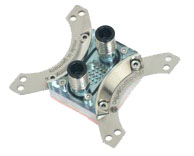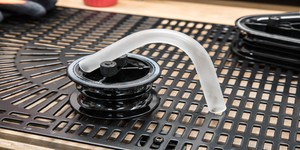
Da Parts
Well, we have a somewhat better idea of why water works better than air now, so it's on to the next question - what do we need? Unfortunately, as mentioned in the beginning, water cooling is far from the "cheap" option - but you do get to play with some pretty neat toys.Let's take a look, shall we?
The reservoir
The reservoir serves little practical purpose, designed mostly to have some place to show off your cool fluids and providing a convenient fill point (in some cases, at least). They come in all manner of shapes and sizes, though keep in mind that they mean you need extra fluid in your loop to compensate for them. If you don't feel like using one, then don't - a simple T-junction serves just fine for a filling point, and contrary to popular belief that does not need to be at the highest point of your loop.
The copper fins from a BlackIce radiator are
soldered on to promote a higher heat transfer.
The radiator
The radiator is the equivalent of the "fins" part of our heatsink in air cooling - in fact, it does basically the same thing. Water flows through the radiator's copper (or aluminum) pipes, allowing the heat to dissipate to the fin array on either side. The fins are soldered on for higher end radiators, though some cheaper ones use epoxy to connect them. Though they are usually painted, this won't affect performance as the paint is microns thick.These fins are then cooled by the fans which are attached, usually via a shroud. BlackIce radiators, for example, boast 30 feet of cooling area per square inch of radiator. The copper fins cover a maze of pipe, filled with plenty of angles to maximise surface area there as well. This level of contact with the air, as well as the compact warren of tubing inside, makes for a tremendously efficient cooling mechanism.
Originally, water coolers had to use old car heater cores, which is still the favoured choice amongst the most hardcore old-school. These are big, bulky and often not much (if any) cheaper than their made-for-computer cousins, such as the Black Ice or Airplex radiators. They usually come in sizes of 120, 240, or 360mm, which is due to the size of the fans used for them.
The Pump
The pump is liable to be the most expensive part of your water cooling system, and it ought to be. You need something with some considerable power, but it needs to fit in a cramped space and preferably not sound like a plane is taking off. It also needs to be as unbreakable and well-sealed as possible, so a magnetic impeller (the thing that pushes the water) is a must.That leaves pretty much any centrifugal pump available from brands like Eheim and Laing, who supply most of the pumps out on the market for water cooling today. Contrary to popular belief, you do not need the biggest pump that you can afford - but it's best not to skimp, either.
High end pumps like the Laing D5 even have variable flow rates, but don't be drawn in by a bunch of bells and whistles that you don't need. Whilst these types of things are a god-send to those of us who test blocks, most people will be quite comfortable without such fripparies, and can instead go for things that have a smaller footprint or a nicer look to them. That being said, if you really want to tinker, the options are there.
The Block

The Aqua Computer Cuplex XT is the
best low-flow block right now.
Despite what anyone says, there is no such thing as a low-flow block - all blocks prefer a higher flow rate. That being said, some blocks are better at low-flow setups than others are at twice the flow. As the time of this writing, the Aqua Computer Cuplex XT is the best-performing block for low-flow setups known by me. I am more than happy to be corrected if I'm wrong, though.
The Tubing
The thing that ties everything together - tubing comes in four different flavours.- Silicone tubing is slightly porous and largely opaque, so it's fine if you don't plan on lighting your tubes up at all, and don't mind refilling.
- PVC tubing is clear and non-porous, but tends to yellow over time and is not the world's most flexible - it tends to kink a lot at any relatively sharp bend.
- Tygon tubing is the top of the line, laboratory-grade stuff. It's crystal clear, bends easily and won't yellow out. Of course, you pay for that - it's a tad on the pricey side.
- Clearflex tubing is the knock-off, poor man's Tygon. It's essentially the same stuff, without all the cost - but it isn't quite as good in many respects.
The type of tubing that you choose is largely dependent on your budget and the size you need (discussed later). Some of it even comes in pretty colours!
Now, we just have to hook them all together. Which brings us to...

MSI MPG Velox 100R Chassis Review
October 14 2021 | 15:04








Want to comment? Please log in.